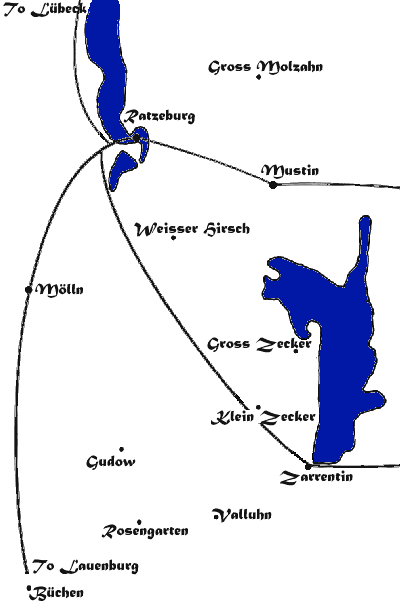





Main Moves. September 2nd to November 10th.
Davout was informed that Oudinot had been defeated in at Gross Beeren near Berlin. This changed the situation for XIII corps still occupying the Schwerin-Wismar line. Davout decided to fall back to the river Delvenau. From a position behind the river he would stand a better chance at defending Holstein and Hamburg. The march to the new lines began the following day. Marching in 3 columns, the XIII corps left it’s positions near Schwerin and Wismar. The Danish auxiliary corps acted as a rearguard during the march. The rearguard was constantly attacked during the march back to Ratzeburg, which they reached on September the 4th . L´Allemans brigade marched from Wismar to Lübeck. Here he positioned himself in the terrain near Dassau and Schönberg. XIII Corps now occupied a defensive position running from Travemünde to Lübeck and south to Ratzeburg and along the Devenau and on to Lauenberg. The troops had taken up positions behind the small rivers Wackenitz and Delvenau. In the middle of the defensive line was the fortification Ratzeburg, where a strong bridgehead position had been set up. The bridgehead was to be the basis for offensive operations if XIII corps was ordered on the offensive. The XIII corps occupied this strong defensive line centred on Ratzeburg until November the 12th. There were daily clashes with probing enemy forces. A larger battle took place near Ghörde, south of the Elb River on September the 16th. Lieutenant General Pecheux marched south towards Ghörde with the 50th Division. Davouts plan was to use the 50th Division as a diversion that would take the enemies attention away from a vital French ammunition transport moving from Hannover to Magdeburg.
Walmoden was already aware of the ammunition transport and of the movements of the 50th
Division. A trap was set up near Dannenberg to surround and destroy the 50th Division, but
Pecheux stayed in his position at Ghörde, and therefor avoided disaster. Walmoden had no
intentions of letting a chance to destroy an enemy division be wasted. Instead of waiting
for the 50th Division at Dannenberg Walmoden went on the offensive and attacked Pecheux in
his position at Ghörde. Walmoden concentrated a force five times bigger that Pecheux´s,
which Walmoden hoped would swiftly crush the French 50th Division. Pecheux manoeuvred with
great skill to disengage from the attacking enemy without endangering his division. The
50th Division returned to it’s previous defensive positions North of the Elbe River.
During the entire engagement Davout did nothing to support or assist the desperately
outnumbered Pecheux.
Several other skirmishes took place in the vicinity of the Ratzeburg fortifications. Most of these in the area south-east of Ratzeburg. On September the 17th Davout suddenly decided to mount a reconnaissance commanded by Lieutenant General Wattier towards Zarrentin. Enemy forces occupying the town was pushed back to Wittenburg. Wattier returned to his position in the defensive lines after the battle. Wattiers advance towards Zarrentin had been covered on the right flank by Danish cavalry. On the 18th a Danish cavalry squadron became engaged at Gudow, where a Cossack regiment had been encountered. The Danish squadron routed the Cossacks and secured Wattiers flank. On the 26th another skirmish took place at Gudow. The Danes tried to ambush a Cossack force stationed there. The ambush failed due to French incompetence but the 60 Danish dragoon managed to rout more than 300 Cossacks. Both sides would perform patrols into the villages around Ratzebrug to gather forage. On September the 30th, the Prince of Hessen ordered the advance of a sizeable Danish force towards Klein Zecker. Their mission was foraging. Food and other supplies should be gathered from nearby villages. At Klein Zecker a skirmish with enemy forces evolved. The Danes completed their mission covered by their light troops they withdrew with several wagon loads of supplies. After the battle near Göhrde, Walmoden quickly retired to a defensive line running from Rehna to Hagenow.
Map of the Rendsborg area. Click on map to see battleinfo.
The front was quiet for some time until Walmoden came under increasing pressure from Sweden. He was forced to start offensive operations, although Walmoden had no real desire to fight. Walmodens plan was to strike at the centre of the XIII corps, near Ratzeburg and Mölln. The fighting quickly became fierce as Walmodens numerically superior force ran into defensive positions held by French and Danish forces. On October the 6th French forces fought at Mustin, Gross Molzahn and Büchen. The determined French defenders they repulsed all attacks. After these failed attacks Walmoden abandoned his plans of a frontal assault on the Danish held Razteburg fortification. Instead he ordered a strong reconnaissance towards the town. The reconnaissance force hit a strong Danish defensive position in Weisser Hirsch on October the 7th. Fighting was fierce and lasted several hours before Danish cavalry routed the attackers. Walmoden broke off the offensive after 10 days of fighting. Their results of the offensive were depressing. He had suffered severe casualties and had made no major territorial gains. Once again he withdrew to the position along the Rhena - Hagenow line. During Walmodens retreat the Danes performed a reconnaissance towards Gudow. Danish cavalry clashed with enemy near Rosengarten, where the Danish dragoons won a spectacular victory. Later XIII corps performed a major reconnaissance on October the 18th. Two columns marched to Valluhn and Zarrentin. Several skirmishes took place with enemy forces without any major battle taking place. The Razteburg front was quiet until November the 8th when a patrol was sent to the Gross Zecker manor. Davout wanted some important papers located in the manor. The Danes encountered a strong enemy force at Gross Zecker, during a delaying action the papers were retrieved and the Danes withdrew from the field.